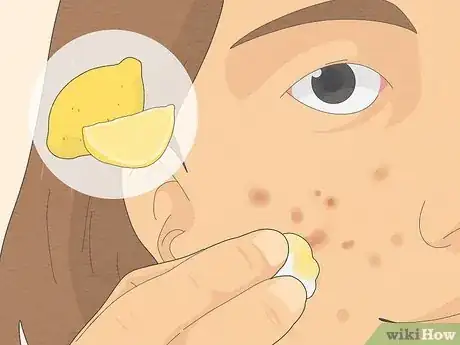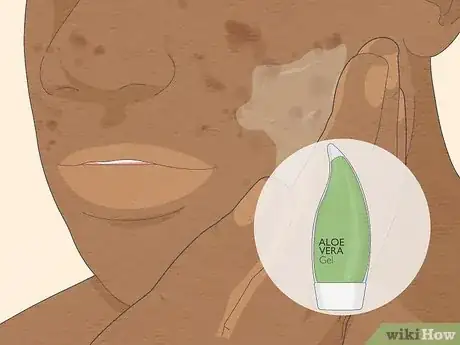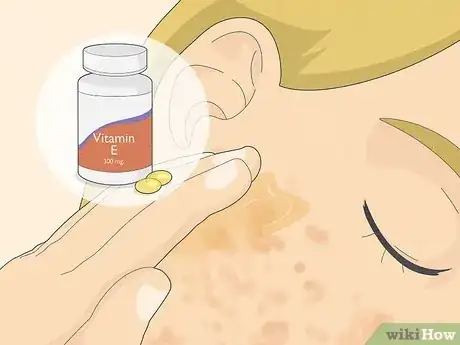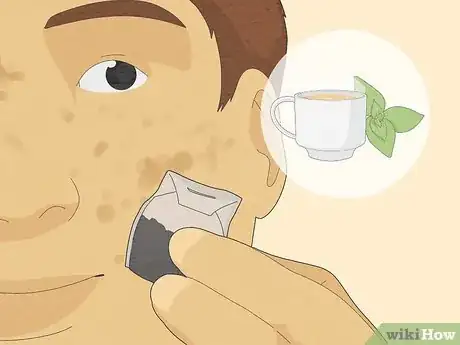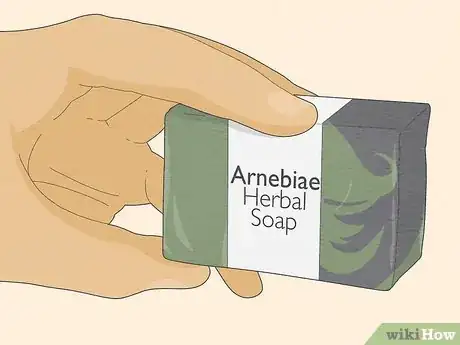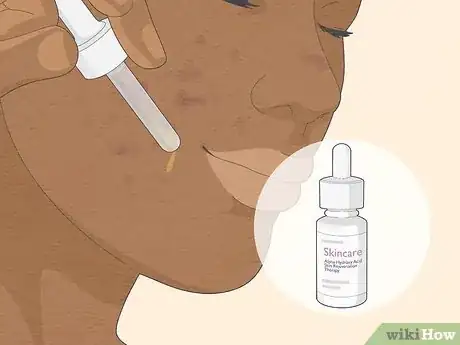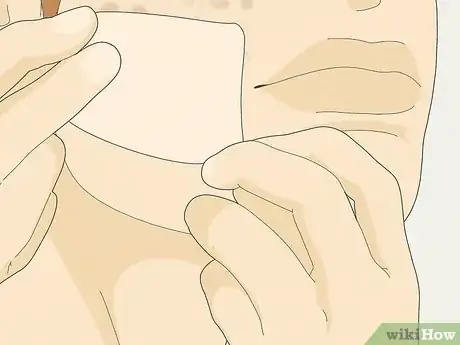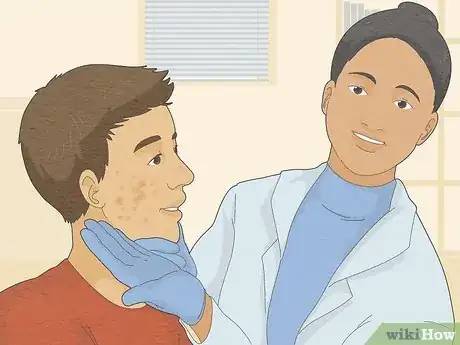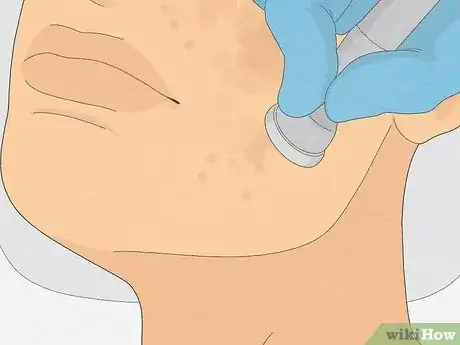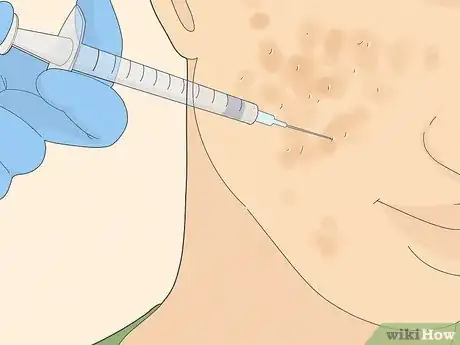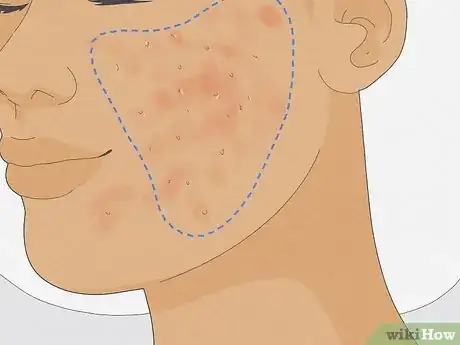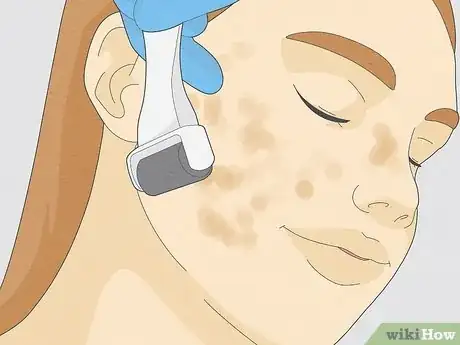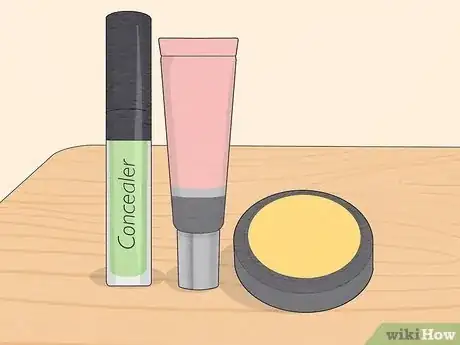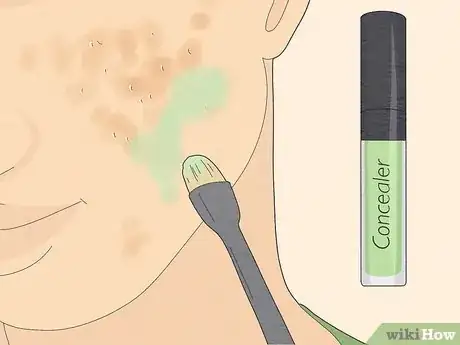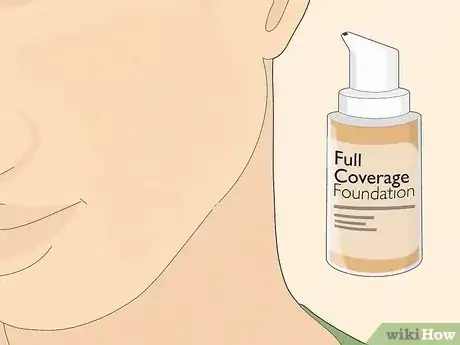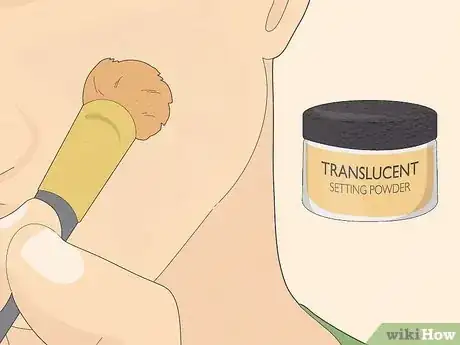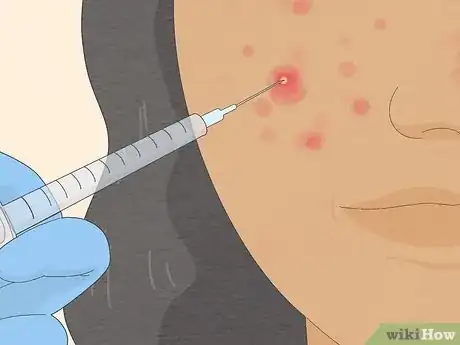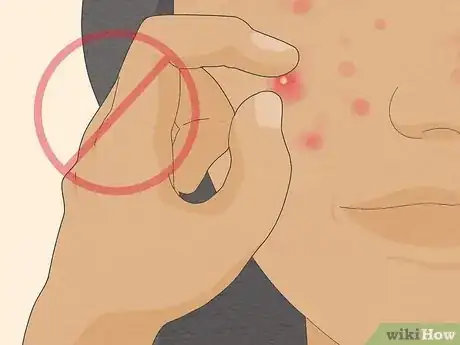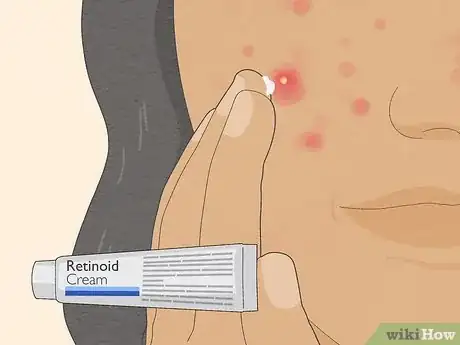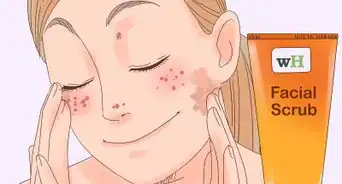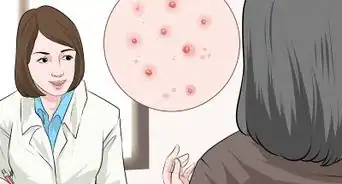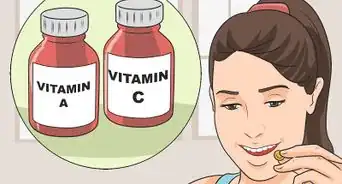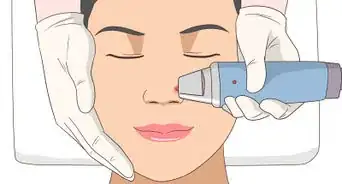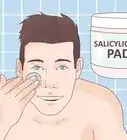This article was medically reviewed by Kate Holcomb, MD and by wikiHow staff writer, Jessica Gibson. Dr. Kate Zibilich Holcomb is a Board Certified Dermatologist and the Founder of Pure Dermatology. She has over 15 years of experience in the field and specializes in cosmetic dermatology. Dr. Holcomb earned an MS in Public Health and Parasitology from The Tulane University School of Public Health and Tropical Medicine and an MD from Tulane University School of Medicine. She also completed her residency in dermatology as Chief Resident at Saint Luke’s-Roosevelt Hospital Mount Sinai. Dr. Holcomb is a member of the American Academy of Dermatology, American Society of Dermatologic Surgeons, American Acne and Rosacea Society, Skin of Color Society, North American Contact Dermatitis Society, Louisiana Dermatological Society, and Women’s Dermatologic Society.
There are 24 references cited in this article, which can be found at the bottom of the page.
This article has been viewed 257,652 times.
Most people experience some form of acne at one point in their lives. Unfortunately, some types of acne can be severe, forming abscesses on the skin. Cystic acne is most common during the teenage years since changing hormones can increase the production of oils that trap bacteria in your pores. Since cystic acne can be painful, inflamed, and develop deep in your skin, it can cause scars. Fortunately, you can try remedies at home to reduce the appearance of scars before resorting to medical treatments.[1]
Steps
Using Home Remedies on Cystic Acne Scars
-
1Research and take precautions with home remedies. There are a lot of home remedies that can reduce the look of your cystic acne scars. But, just because something claims to be natural doesn't mean it's safe. Read up on the ingredients involved in remedies and avoid ingredients that you're sensitive or allergic to.
- If you're thinking about buying an over-the-counter home treatment for scar removal, research the product first.
-
2Apply lemon juice to the scars. If you have darker cystic acne scars, the vitamin C in lemon juice can improve wound healing. Use a cotton ball or cotton swab soaked in lemon juice and apply it directly to your scar. If you have sensitive skin, then dilute the juice with water or with a non-comedogenic oil, such as argan oil.[2] Let the juice air dry before rinsing your skin with warm water. Repeat this once a day.[3]
- Do not expose your skin to the sun while you have lemon juice on it. The lemon juice makes your skin more sensitive to the sun.
Advertisement -
3Massage aloe vera onto the scars. Cystic scar tissue may feel firm or rough. Applying aloe vera gel into the scar may soften the scar tissue. Use gel directly from the aloe vera plant or purchase an aloe vera gel that doesn't contain many additional ingredients.[4]
- Aloe vera may improve the appearance and characteristics of scars.[5] It's an anti-inflammatory herb which helps increase the elasticity of the new skin tissue.
-
4Massage vitamins into the scars. Choose a gel caplet of vitamin E that contains 400 IU in liquid form and choose a gel caplet of vitamin D that contains 1000 to 2000 IU in liquid form. Open each gel caplet and squeeze the vitamins into a small bowl. Mix in 8 to 10 drops of castor oil and massage the mixture onto your scar. Leave the vitamins on your skin to improve the appearance of your cystic acne scars.[6] [7]
- Or, you could try mixing 2 to 3 drops of lavender oil or St John's wort oil into 2 tablespoons of castor oil for a healing massage oil. St. John's wort oil is often used to heal c-section scars.[8]
-
5Use a green tea compress. Steep a bag of organic green tea in warm water to soften it. Place the tea bag directly on your scar for 10 to 15 minutes. Do this 3 times a week and work your way up to using the treatment daily. You can also soak a cotton towel in green tea, squeeze out the excess and place it over the scar.
- Green tea may minimize scarring because it contains antioxidants that help your skin heal.[9]
-
6Use Radix arnebiae (R arnebiae). This herb has been used in Traditional Chinese Medicine (TCM) for centuries to reduce scarring. Get R. arnebiae from a TCM practitioner or purchase an R. arnebiae soap, powder, or concentrated herb form. To use the powder, mix ½ teaspoon of the powder or ¼ teaspoon of the concentrated herb with 1 to 2 tablespoons of castor oil. Massage the mixture into the scar tissue 3-4 times a week and then work up to daily use.[10]
- R. arnebiae is also known as Zi Cao and lithospermum erythrorhizon. In TCM, it's characterized as a heat and toxin releaser. Studies show that it can reduce the numbers and functions of scar-forming cells.
-
7Try an at-home glycolic acid peel. You can use a glycolic acid peel to minimize the appearance of acne scars.[11] Look for a glycolic acid peel product that you can use at home and follow the instructions carefully.
-
8Apply a silicone bandage. Silicone bandages can help to reduce the appearance of acne scars as well. The bandage has to be worn continuously, so consider whether you are willing to wear a bandage on your face for an extended period of time, possibly for several months.[12] You can buy silicone bandages over-the-counter.
Getting Medical Treatments For Cystic Acne Scars
-
1Get an examination. While you can try home remedies or over-the-counter treatments, if you don't see any improvement in your acne scars within 6 to 8 weeks, you should see a dermatologist. Acne can be painful and the scars probably won't go away on their own so getting medical attention is important.
- Your primary care physician may need to refer you to a dermatologist in order for your insurance to cover the exam. Or, your doctor may simply recommend dermatologists who specialize in cystic acne.
-
2Try dermabrasion or microdermabrasion. Dermabrasion or microdermabrasion removes the top layers of skin and is used for small scars. It is the most common treatment for acne scars. The dermatologist may apply a local anesthetic and will use tools that carefully sand away the top layer of skin. If your cystic acne covers a large area of skin, your dermatologist may give you a sedative or recommend general anesthesia if your procedure will be more complex.[13]
- Your skin will be red and swollen after the treatment. The swelling should go down within 2 or 3 weeks.
-
3Do chemical peels. If you have more severe acne scars, the dermatologist may want to remove the topmost layer of skin. For a deep peel, you'll probably get general anesthesia so you'll be asleep during the procedure. The dermatologist will apply the chemical peel to small patches of your skin and remove it along with your top layer of skin which will remove the cystic acne scars.[14]
- If you had a deep peel, the dermatologist will show you how to change your surgical bandages after the procedure. If you had a moderate peel, you'll probably need to apply cool compresses and lotion.
-
4Fill the cystic acne scars. If you have ice pick (punched-out) scars, you may be able to remove them by getting a dermal filler injection. During this procedure, collagen (a protein approved by the FDA) is injected under your skin to fill in the pits caused by acne.
- Your dermatologist may also use steroid injections for scars that are hyper-pigmented or darker than surrounding skin.
-
5Use laser and light therapies. Pulsed dye lasers or intense pulsed light can be used to treat raised acne scars. These high energy light beams burn away damaged skin and scars. Once the scars have been burned away, your skin is more likely to heal normally and without any scarring.
- Less intensive lasers and lights can be used to leave your skin intact while stimulating the collagen underneath your skin.[15]
-
6Get small skin grafts. Small skin grafts (also known as punch grafts) are usually used to treat deep cystic acne scars, especially if they don't respond well to other treatments. During the graft, the dermatologist will punch a hole to remove the scar. The scar is replaced with your own skin (which usually comes from behind your ear).[16]
- Be aware that many insurance policies may not cover scar removal because it is considered to be cosmetic surgery unless the scar is a physical impairment. Check with your insurance carrier to find out what your policy covers.
-
7Ask about collagen-induction therapy. For this form of scar treatment, a dermatologist runs a roller with small needles on it over the scarred area. Each needle punctures your skin and as the puncture wounds heal, your skin produces collagen which helps to fill in the gaps in and around the scars. Multiple treatments are required to get the best results from this treatment. You will also have some swelling as a result of the therapy, but it is only temporary.[17]
Concealing Cystic Acne Scars
-
1Select a concealer to hide the scars. Look closely at your scars to figure out what color they are. Select a concealer or foundation color that's opposite to your acne scar color on the color wheel. This will effectively camouflage the acne scar. You could use:[18]
- Green concealer to cover up reddish acne scars.
- Yellow concealer to even out blemish areas caused by scars.
- Pink concealer to balance out purple or dark blemish areas.
-
2Apply the concealer to your scars. Use a thin brush that is slightly feathered at the end to apply the concealer. Place a pea-sized amount of concealer on the back of your hand and rub the brush into it. Brush a light layer of concealer over the scar.
- You can use your finger to apply the concealer. Just take care not to apply to much or it may actually draw attention to your scar.
-
3Apply a foundation. You'll need to apply a foundation to hide your concealer, especially if your skin tone is a little different than the makeup or you've used a green concealer that's very noticeable. Apply your usual foundation so that your skin tone evens out and the scar is no longer visible.
- Take care when applying the foundation directly over the scar to avoid rubbing away the concealer.
-
4Set your makeup with powder. Let your foundation rest for a minute so that it dries a little. Take a large powder brush and apply your powder with broad upward strokes. You can use a loose powder that you simply dab the brush into and tap. Or, you can rub the brush into a pressed powder and tap it before applying.[19]
- Remember to wash off your makeup every night. This is a habit that will keep your skin healthy and prevent future acne breakouts.
Preventing Future Cystic Acne Scars
-
1Get early treatment for acne. The longer you struggle with acne, the more chance you have of scarring. Improve your skin washing habits, try home remedies and consider over-the-counter treatments for acne. If none of these treats your acne or you have nodules (like a cyst or boil), get examined by a dermatologist.[20]
- A dermatologist can prescribe medications for acne or give you cortisone injections. These injections reduce inflammation and shrink pimples. According to research, treating acne during the inflammation stage can prevent scarring.[21]
-
2Avoid squeezing, popping, or picking your acne. While it may be tempting to squeeze a large pimple so that you can make it smaller, this will make scarring more likely. Squeezing your pimples will push bacteria further down into your skin which will actually make swelling and redness worse.
- Popping your pimples spreads the bacteria causing your acne to other pores on your skin. This can make your breakout worse.
-
3Apply retinoids. Research shows that applying topical retinoids is one of the best ways to prevent scarring caused by acne. Choose a topical skincare product that contains retinoic acid and apply it according to the manufacturer's instructions. Use the product for at least 12 weeks to prevent scarring.[22] [23]
- If you can, choose a product that also contains glycolic acid. Studies show that a combination of retinoic acid and glycolic acid is more effective than retinoic acid on its own.
-
4Quit smoking to improve your skin. If you smoke, take steps to quit or at least cut back. Smoking can damage your skin and there's a link between smoking and impaired wound healing.[24]
- Smoking will also age your skin more quickly and cause wrinkles.[25]
- To prevent dehydration and damage skin, you should also cut back on how much alcohol you drink.
References
- ↑ http://www.medicinenet.com/script/main/art.asp?articlekey=2898
- ↑ https://thebestorganicskincare.com/a-list-of-non-comedogenic-facial-oils
- ↑ Moores, J. (2013). Vitamin C: a wound healing perspective. British Journal Of Community Nursing, 18S6-s11.
- ↑ http://www.ncbi.nlm.nih.gov/pubmed/25003428
- ↑ https://www.ncbi.nlm.nih.gov/pmc/articles/PMC4506744/
- ↑ Pandel, R., Poljšak, B., Godic, A., & Dahmane, R. (2013). Skin Photoaging and the Role of Antioxidants in Its Prevention. ISRN Dermatology, 1-11.
- ↑ Martindale, D. (2000). Scar no more. Scientific American, 283(1), 34-36.
- ↑ Samadi, S., Khadivzadeh, T., Emami, A., Moosavi, N. S., Tafaghodi, M., & Behnam, H. R. (2010). The effect of Hypericum perforatum on the wound healing and scar of cesarean. Journal Of Alternative And Complementary Medicine (New York, N.Y.), 16(1), 113-117.
- ↑ http://www.takingcharge.csh.umn.edu/explore-healing-practices/botanical-medicine/-there-good-scientific-evidence
- ↑ Xie, Y., Fan, C., Dong, Y., Lynam, E., Leavesley, D. I., Li, K., & ... Upton, Z. (2015). Functional and mechanistic investigation of Shikonin in scarring. Chemico-Biological Interactions, 22818-27.
- ↑ https://www.ncbi.nlm.nih.gov/pmc/articles/PMC3875240/
- ↑ https://www.aad.org/public/diseases/acne-and-rosacea/acne-scars#treatment
- ↑ https://www.nlm.nih.gov/medlineplus/ency/article/002987.htm
- ↑ https://www.aad.org/public/diseases/cosmetic-treatments/chemical-peels
- ↑ http://www.asds.net/GeneralDermasurgeryInformation.aspx
- ↑ http://www.skinmds.com/skin/acne-scars/punch-grafts.htm
- ↑ https://www.aad.org/public/diseases/acne-and-rosacea/acne-scars#treatment
- ↑ http://stylecaster.com/beauty/concealer-how-to/
- ↑ http://www.goodhousekeeping.com/beauty/makeup/a32862/cover-acne-scars-with-makeup/
- ↑ http://kidshealth.org/en/teens/acne-scars.html
- ↑ http://www.ncbi.nlm.nih.gov/pmc/articles/PMC2958495/
- ↑ http://www.ncbi.nlm.nih.gov/pmc/articles/PMC4375771/
- ↑ http://www.ncbi.nlm.nih.gov/pmc/articles/PMC2958495/
- ↑ https://www.ncbi.nlm.nih.gov/pmc/articles/PMC4241583/
- ↑ https://www.aad.org/public/skin-hair-nails/younger-skin
- ↑ https://www.aad.org/media/stats/prevention-and-care/sunscreen-faqs
About This Article
If you have cystic acne scars, there are a lot of different remedies that can help you reduce their appearance. One option is to use an at-home glycolic acid peel. Glycolic acid peels deeply exfoliate the skin, which can help reduce the appearance of scars over time. You can also apply aloe vera gel to your cystic acne scars. Aloe vera is anti-inflammatory and can soften scar tissue and reduce the appearance of scars. Your best bet for getting rid of cystic acne scars is working with a dermatologist. They'll be able to recommend a variety of medical treatments that are proven to get rid of scars, like microdermabrasion, laser treatment, light therapy, and fillers. For advice on how to cover up cystic acne scars so they're less noticeable, check out the full article!

